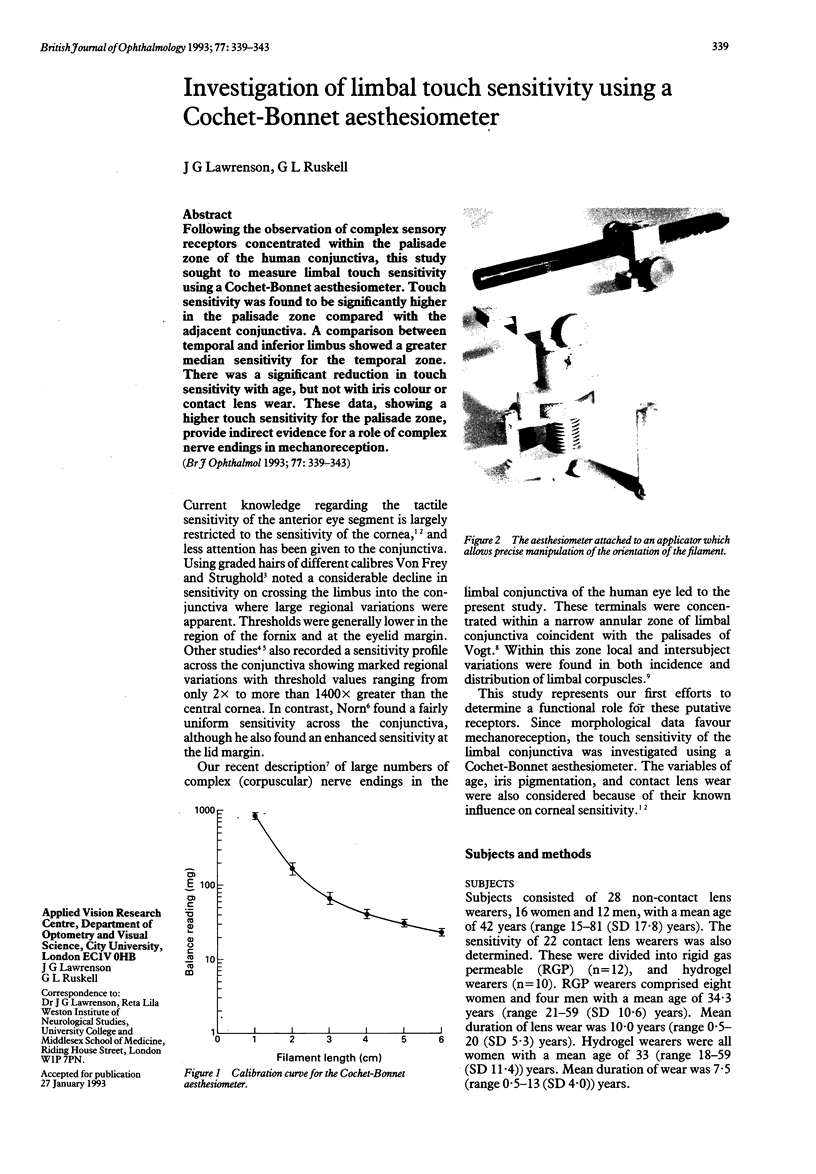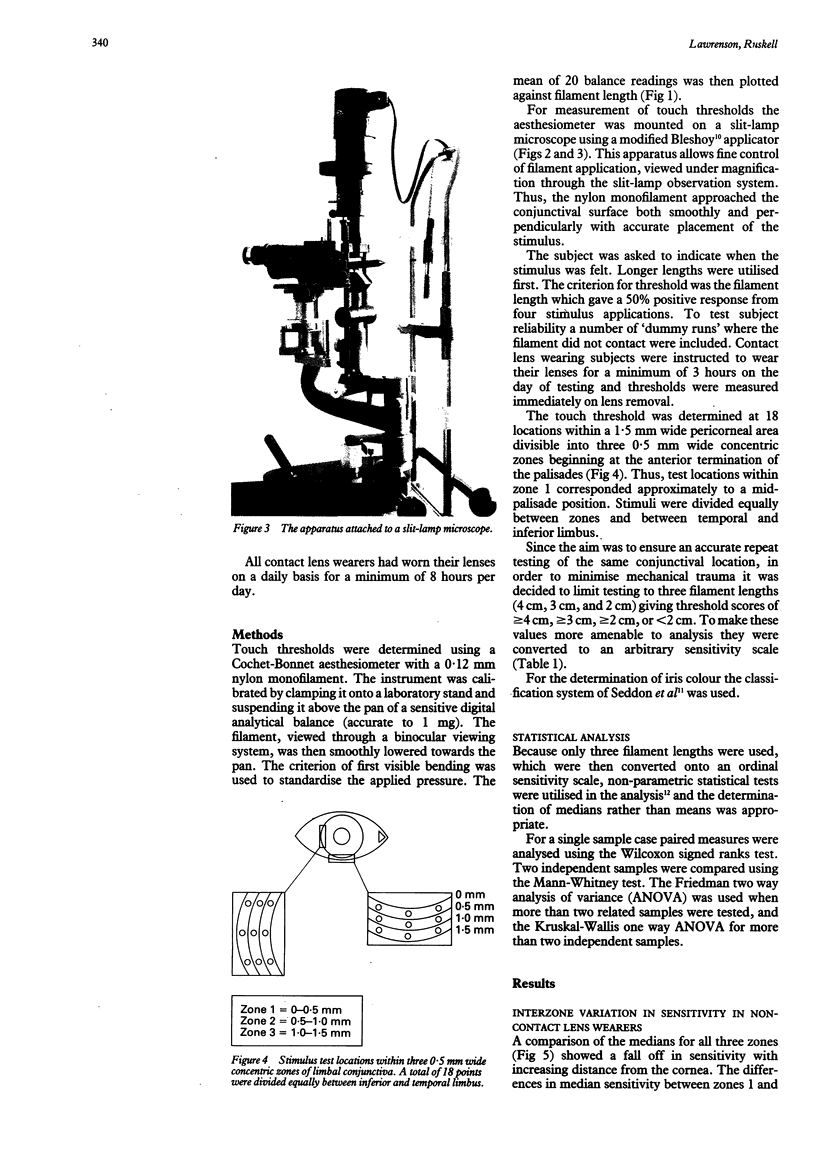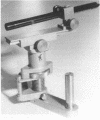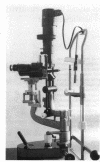Abstract
Following the observation of complex sensory receptors concentrated within the palisade zone of the human conjunctiva, this study sought to measure limbal touch sensitivity using a Cochet-Bonnet aesthesiometer. Touch sensitivity was found to be significantly higher in the palisade zone compared with the adjacent conjunctiva. A comparison between temporal and inferior limbus showed a greater median sensitivity for the temporal zone. There was a significant reduction in touch sensitivity with age, but not with iris colour or contact lens wear. These data, showing a higher touch sensitivity for the palisade zone, provide indirect evidence for a role of complex nerve endings in mechanoreception.
Full text
PDF




Images in this article
Selected References
These references are in PubMed. This may not be the complete list of references from this article.
- BOBERG-ANS J. Experience in clinical examination of corneal sensitivity; corneal sensitivity and the naso-lacrimal reflex after retrobulbar anaesthesia. Br J Ophthalmol. 1955 Dec;39(12):705–726. doi: 10.1136/bjo.39.12.705. [DOI] [PMC free article] [PubMed] [Google Scholar]
- Draeger J. Modern aesthesiometry: contribution to corneal metabolism after anterior segment surgery. Trans Ophthalmol Soc U K. 1979 Jul;99(2):247–250. [PubMed] [Google Scholar]
- Lawrenson J. G., Ruskell G. L. The structure of corpuscular nerve endings in the limbal conjunctiva of the human eye. J Anat. 1991 Aug;177:75–84. [PMC free article] [PubMed] [Google Scholar]
- Lim C. H., Ruskell G. L. Corneal nerve access in monkeys. Albrecht Von Graefes Arch Klin Exp Ophthalmol. 1978 Nov 8;208(1-3):15–23. doi: 10.1007/BF00406978. [DOI] [PubMed] [Google Scholar]
- Millodot M. A review of research on the sensitivity of the cornea. Ophthalmic Physiol Opt. 1984;4(4):305–318. [PubMed] [Google Scholar]
- Millodot M. Do blue-eyed people have more sensitive corneas than brown-eyed people? Nature. 1975 May 8;255(5504):151–151. doi: 10.1038/255151a0. [DOI] [PubMed] [Google Scholar]
- Millodot M. Effect of hard contact lenses on corneal sensitivity and thickness. Acta Ophthalmol (Copenh) 1975 Sep;53(4):576–584. doi: 10.1111/j.1755-3768.1975.tb01776.x. [DOI] [PubMed] [Google Scholar]
- Millodot M. Effect of long-term wear of hard contact lenses on corneal sensitivity. Arch Ophthalmol. 1978 Jul;96(7):1225–1227. doi: 10.1001/archopht.1978.03910060059011. [DOI] [PubMed] [Google Scholar]
- Millodot M. Effect of soft lenses on corneal sensitivity. Acta Ophthalmol (Copenh) 1974;52(5):603–608. doi: 10.1111/j.1755-3768.1974.tb01096.x. [DOI] [PubMed] [Google Scholar]
- Millodot M. The influence of age onthe sensitivity of the cornea,. Invest Ophthalmol Vis Sci. 1977 Mar;16(3):240–242. [PubMed] [Google Scholar]
- Norn M. S. Conjunctival sensitivity in normal eyes. Acta Ophthalmol (Copenh) 1973;51(1):58–66. doi: 10.1111/j.1755-3768.1973.tb08246.x. [DOI] [PubMed] [Google Scholar]
- Ruskell G. L. Innervation of the conjunctiva. Trans Ophthalmol Soc U K. 1985;104(Pt 4):390–395. [PubMed] [Google Scholar]
- Schimmelpfennig B. Nerve structures in human central corneal epithelium. Graefes Arch Clin Exp Ophthalmol. 1982;218(1):14–20. doi: 10.1007/BF02134093. [DOI] [PubMed] [Google Scholar]
- Seddon J. M., Sahagian C. R., Glynn R. J., Sperduto R. D., Gragoudas E. S. Evaluation of an iris color classification system. The Eye Disorders Case-Control Study Group. Invest Ophthalmol Vis Sci. 1990 Aug;31(8):1592–1598. [PubMed] [Google Scholar]
- Winter R., Draeger J., Rumberger E., Lucas I. Zur Sensibilitätsbestimmung an der Bindehaut--Methodik und erste klinische Befunde. Fortschr Ophthalmol. 1986;83(2):176–178. [PubMed] [Google Scholar]




